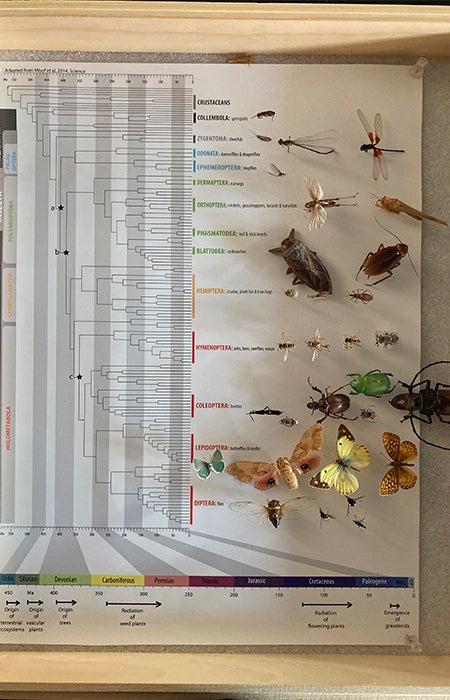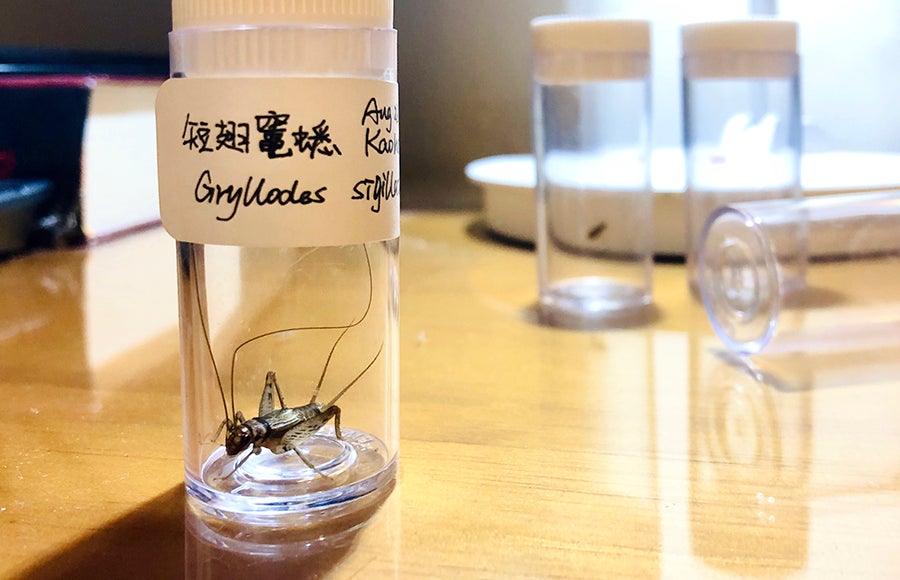
From L.A. to Taiwan, USC students hunt down insects to better understand ecology
A few minutes into conversation with Julie Hopper, a lecturer in environmental studies and biological sciences at the USC Dornsife College of Letters, Arts and Sciences, and you’ve probably touched on a blitz of topics, anything from the evolutionary impact of trophy hunting on big horn sheep to the sex changes of parrotfish.
Much of this information comes from her academic background, which is impressively diverse. She majored in biology at the University of California, Santa Barbara, intent on becoming a marine biologist. A course in parasitology changed her mind.
“I was like, ‘Screw fish; parasites are awesome!’” she says.
She then dived up and down the coast of California studying parasites in aquatic species.
Next, she earned her Ph.D. at the University of California, Berkeley while researching insect population control. Recently, she was a post-doctoral scholar at the Caron Lab at USC Dornsife, researching algal bloom parasites.

Her work there hit a serious obstacle: A year-long experiment failed due to contaminated samples. She hasn’t let it dampen her spirits. This past summer she returned to research, looking at an invasive beetle and fungus that attack many native California trees.
Her resilience has proven useful during the pandemic as professors are pushed into unexpected challenges. Forced to abandon her usual in-person activities for her Ecology 315 course, like tracking down parasites from snails in wetlands or examining cricket behavior in the lab with her students, Hopper got creative.
Bug hunters abroad
Every semester, Hopper’s students get a chance to play Charles Darwin. Throughout the term they snare insects while on class excursions, then pin and label specimens onto a board. By the conclusion of their classes, each has a keepsake insect collection.
Hopper was determined to retain this tradition, even in a pandemic that was making field trips almost impossible. And while rows of pegged bugs might make some a little squeamish, Hopper argues that fundamental scientific concepts like natural selection spring from the study of these rather morbid displays.
“How did famous naturalists come up with their theories? It was through collections. You collect organisms, compare them and make hypotheses about why they look the way they do,” explains Hopper.
With her students scattered across the globe, she outfitted home collection kits so that students could hunt in their own backyard. Pins, boxes and an aspirator (used to safely suck bugs into a jar) were packed by Hopper and handed out to those near campus.

Students farther afield, like Yunqian Hsu, an animation and digital arts major at the USC School of Cinematic Arts, received theirs in the mail. Hopper shipped Hsu’s all the way to Kaohsiung City, Taiwan.
Hsu is now trapping insects near her home in the city and at her grandmother’s house in the countryside township of Dashe. She’s been comparing the diversity of insects between rural and urban areas.
“I’ve collected several butterflies and two dragonflies at my grandmother’s [home],” says Hsu “I also caught a cricket at an elementary school in my neighborhood. Catching insects is fun, and through the process of identifying them, I learned the amazing diversity of them that I never knew before.
Bugs among us
Some activities in Hopper’s class can remain the same, with appropriate modifications. On a recent September morning, students gathered on campus (masked and distanced) to study the impact of surrounding vegetation and pesticide use on arthropod biodiversity. Hopper worked with USC Facilities Management Services to locate areas where landscaping crews had recently sprayed pesticides and compared those to areas without recent pesticide application.
Students mixed soap and water together in red Solo cups, dug holes and placed the cup traps in the hollow. Unsuspecting insects or isopods like pill bugs tumble into the liquid where students retrieve them later for research. Returning to campus, even for a brief afternoon, was an enjoyable break from Zoom for students like Jared Khan, a quantitative biology major.
“It gives me the chance to get out of the house and walk around campus — something I never thought I’d miss so much,” says Khan.
Curious what kind of insects make campus their home? “Definitely a lot of the invasive Argentine Ant,” says Hopper. These are the same little bugs that merrily invade picnics on McCarthy Quad.
Adapt and fight on
Hopper isn’t done coming up with ways her students can learn and grow despite a pandemic. She’s hoping her class can present their research projects at the annual Undergraduate Research Symposium this spring.
That would mean that students like Khan could showcase their course work to a larger audience. His final project for Hopper’s class will be on his research under Kayce Bell, assistant curator of terrestrial mammals at the Natural History Museum of Los Angeles County, examining lice and pinworms found on chipmunks.
All this adjusting hasn’t phased Hopper, who is just grateful for a chance to be teaching what she loves. Demonstrating how to operate a butterfly net while wearing a face mask may not have originally been on her plan for the semester, but Hopper has readily pivoted.
“In teaching, you’re constantly learning new things,” she said.